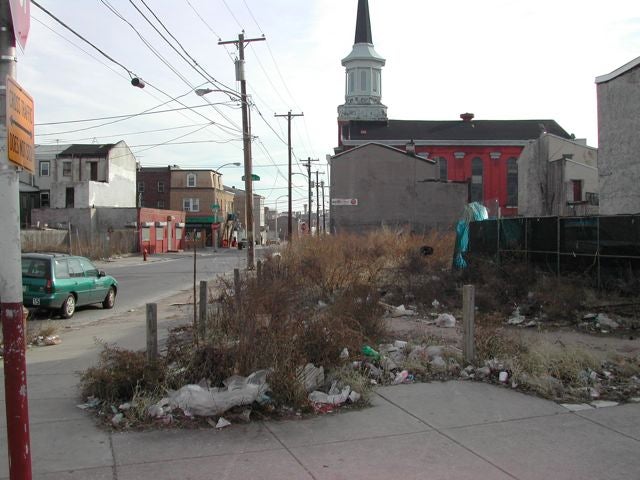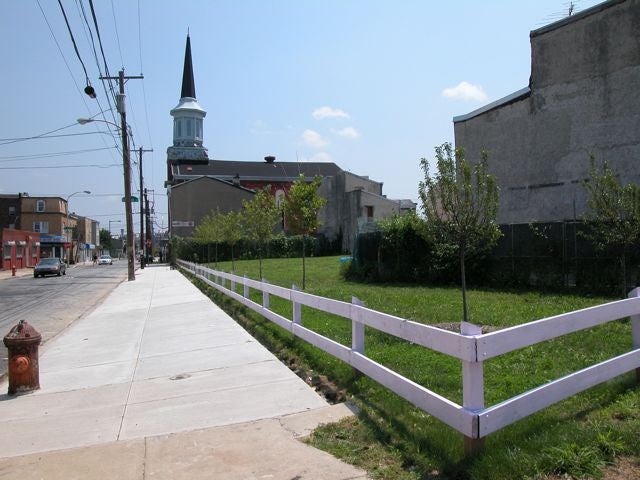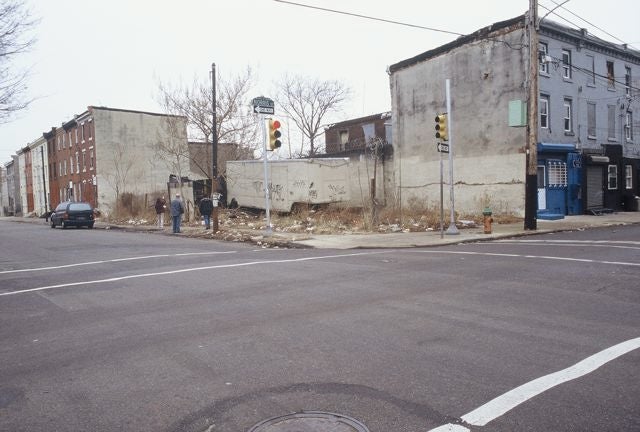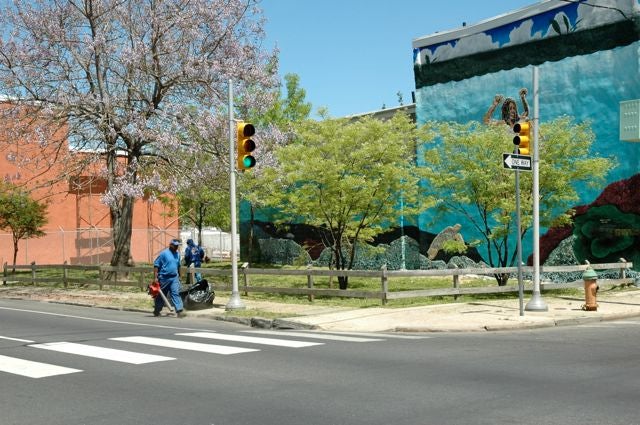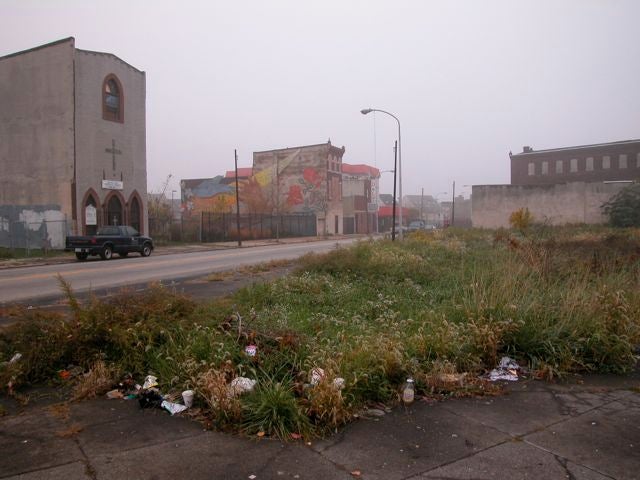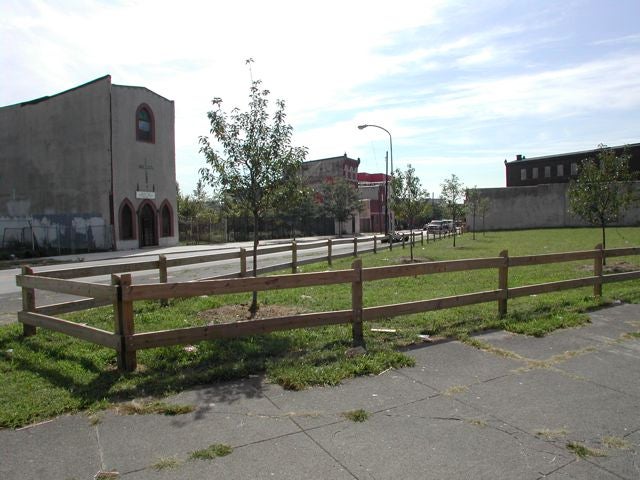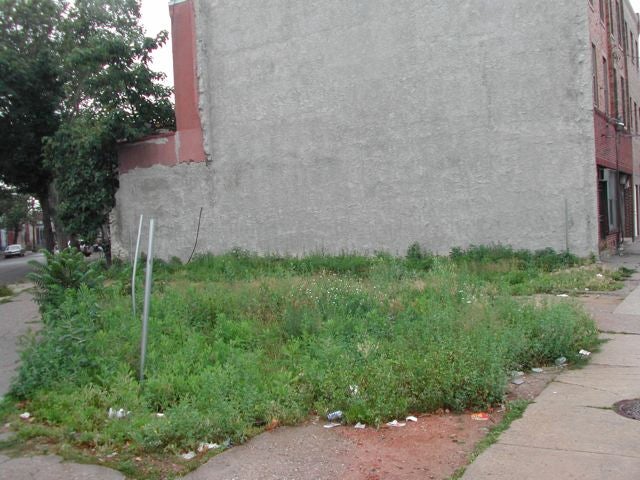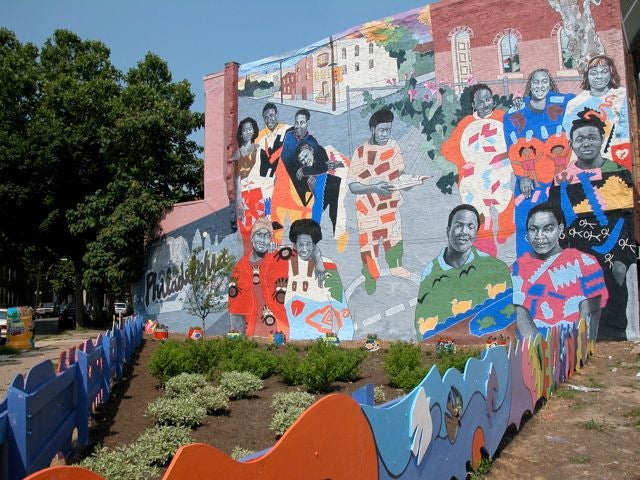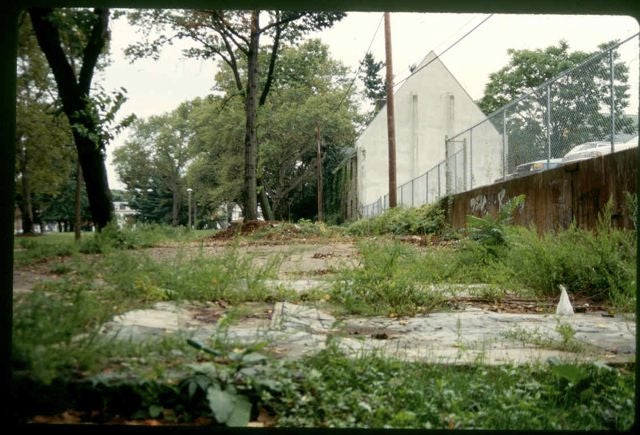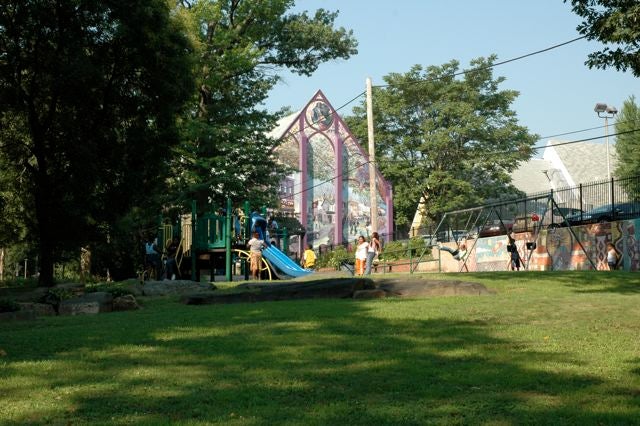Looking beyond cities’ ‘broken windows’
Jan. 28, 2010
By Thomas J. Walsh
For PlanPhilly
For criminologists and sociologists, the “broken windows” theory on urban blight is now almost 30 years old. It has been used by everyone from big city mayors to senior planning officials to block captains and anti-graffiti activists around the world.
The theory, with its many offshoots and corollaries, is evolving, and is now being studied by a group of professionals who are blending all of the above with the most basic of human services: healthcare and personal well-being.
Far beyond broken windows in tough urban settings, deteriorating conditions are directly related to anti-social behavior, said J. Blaine Bonham, Jr., executive vice president of the Pennsylvania Horticultural Society and the moderator for last Thursday evening’s Urban Sustainability Forum at the Academy of Natural Sciences on the Parkway.
Bonham cited the Philadelphia Redevelopment Authority’s estimate of 40,000 abandoned properties within the city limits as he launched a panel convened to talk about new experiments in underlying causes of poor health among the urban poor (and those not-so-poor but living near, or in, blighted neighborhoods).
Guests also discussed the benefits of greening abandoned lots, using methods that are much simpler and a great deal less expensive than creating full-scale playgrounds, and quicker on the turnaround than dealing immediately with serious remediation efforts and permanent landscaping.
Vacancy as epidemic
With current high unemployment rates, especially among urban minorities, combined with a continued escalation in gun deaths, health statistics related to blight and vacant land are going from theory to proven science, explained Dr. Charles Branas, associate professor of epidemiology and director of the Cartographic Modeling Lab at the University of Pennsylvania.
Branas spoke of the “host, agent, environment” model that epidemiologists bring to urban health: just as a mosquito carries malaria, the presence of handguns brings inevitable health problems. Both bring disease, illness, hospitalization and death. Mosquitoes and guns result in health problems that are expensive to treat – monetarily and emotionally. Both, too, are the end result of a specific type of environment.
Another area Branas has studied includes take-out alcohol outlets (in Pennsylvania, this is mainly take-out beer joints, not bars, where malt liquors with high alcohol content are sold). When “anchor” businesses such as banks or supermarkets leave a neighborhood, alcohol outlets often step in, he said. And when alcohol availability goes up, a cycle starts.
As consumption rises, neighbors living near establishments that sell take-out booze have a significantly higher risk of violence, he said. Measures taken by proprietors to protect themselves ratchet up quickly to bullet-proof glass, meaning the owners have very little contact with customers and the community. At least in a regular bar, the bartender could cut a drunk off, Branas said.
As disorder of this type escalates (ironically, bullet-proof glass in this scenario could be seen as analogous to broken windows), and incivilities increase, Branas said that criminals are emboldened. Residents are then less willing to step in. The result is that the above symptoms, over time, lead to out-migration and flight. Abandoned, vacant land increases. Property values decline, setting the entire cycle in motion again.
Branas showed a mapping undertaken of the city’s vacant properties, and compared it with one where assaults happened.
“They look very close to one another,” Branas said. “In fact, vacant properties were the most strongly related factor in this study to the occurrence of assault in the city of Philadelphia. These outpaced many other indicators. Things like unemployment, poverty, educational level in the neighborhoods, were dwarfed by the number of vacant properties that were in them.”
Branas and Penn eventually started to partner with the Pennsylvania Horticultural Society to look at the effects of vacant land. The idea was to look at what PHS can do with vacant lots – even if it is just temporary clearing, with simple grass replacement and some trees – and find out if the symptoms could be abated by reducing crime and advancing health.
Early analysis confirms that vacant land “stabilizations” around the city via PHS “definitely corresponds with reductions in crime,” Branas said. Next steps will involve more formal experiments, moving on from correlations and seeking specific causations. There will also be a look at “targeted greening” – randomly selected lots that are greened and compared to others that remain blighted.
The epidemic is getting national attention, and Branas said some studies like his are getting funding from the likes of the Centers for Disease Control and the National Institutes of Health. The interest is not just with violent crime, but the effects of vacant properties on health factors such as fear, domestic abuse and stress.
Along with PHS, Penn is partnering with Drexel and Temple Universities, Children’s Hospital of Philadelphia, the police department, community groups in West Philadelphia and other local groups to move forward with the studies.
Night and day
Bonham, for his part, presented some pretty compelling evidence from among the 10 million square feet of formerly vacant land – about 10,000 formerly vacant lots – that has been transformed into parks or park-like green settings.
“This is not fancy horticulture,” Bonham said. “It’s just simple greening.”
Before and after photographs are striking. Temporary green spaces with wooden horse fencing can be found at 7th and Germantown Avenues, and at 5th and Norris Streets. New, simple parks on the spots of formerly dangerous parcels are at 4th and Cecil B. Moore, too. He showed the “stunning transformation” of The Spring Gardens in Fairmount, and at Muhammad Park, where 49th Street meets Girard and Lancaster avenues.
Bonham said that one PHS program, Philadelphia Green Community LandCare, is growing to meet the overwhelming needs of blighted neighborhoods. Currently, LandCare maintains vacant lots and some green spaces, employing about 100 people through community development corporations – many of them with criminal records. There is an emphasis on lots adjacent to main corridors and thoroughfares, new development on derelict properties, and greening or development near schools and recreation centers.
Some 16 community groups maintain about 2,500 lots, he said.
Playless playgrounds
Another guest, Dr. Caterina Roman, an assistant professor at Temple’s Department of Criminal Justice, spoke directly to the issue of crime prevention in urban outdoor spaces in terms of “situational characteristics,” such as the amount of light on a given street and the time of day when residents are most vulnerable.
Crime “leads to fear, and then we don’t use our spaces,” said Roman, who spent about 20 years with the Urban Institute, a national economic and social policy organization in Washington, D.C., before arriving at Temple in 2008. Roman says that official data on the subject has it that “levels of fear of crime are independent of reported crime,” and “is a stronger predictor of areas of physical activity [or inactivity] than actual levels of crime.”
That directly influences how children play, or don’t play. The health trade-offs at a playground where no children play are profound. If such a spot is known for drug activity, violence and overdose deaths are the obvious hazards, along with discarded needles and crack vials. But the absence of children at play results in childhood obesity, a much more sweeping epidemic among American urban children.
Other things that affect a neighborhood’s presence include extra safety measures – many door locks, iron bars or gates over shop windows, motion detectors and alarms, etc. – that become conspicuous warning signs to outsiders, heightening the real or perceived sense of danger. So, too, is the effect of extra policing techniques.
“We have to think about what we’re doing in our environment and how it manifests in people’s reactions,” Roman said. “Neighborhoods and the people in them shape what works. … Block by block there are different characteristics of people, of the environment, even within the same small neighborhood. There’s no silver bullet on what works.”
Reinvestment, crown jewels
Also on the forum was Nilda Ruiz, a City Planning Commissioner who is president and CEO of Asociación Puertorriqueños en Marcha (APM), a North Philadelphia CDC involved with education, housing and health and human services. Greening, she said, is an invaluable organizing tool as well as an end in itself.
Ruiz spoke of the transformation of certain blocks adjacent to Temple University, and the success of the much-needed Cousin’s Supermarket, which was built more than a decade ago, and the exhausting but ultimately successful effort to bring a bank into the neighborhood: TruMark Financial Credit Union.
She also spoke of APM’s “latest little crown jewel” at 9th and Berks Streets – the redevelopment of the Temple Regional Rail Station, using a specific transit-oriented development scheme that the Planning Commission hopes to use as a model for other parts of the city.
With PHS, APM has stabilized 20 acres and invested about $70 million. Property values are up substantially in the areas affected.
Michael DiBerardinis, the city’s parks commissioner, said he’s been involved in a civic engagement process around the merger of the parks and recreation departments (which goes into effect this coming July) since last spring. With the city’s public libraries, also under his umbrella, the new department will oversee about 14 percent of the city’s land mass – or some 12,000 acres.
“We are literally in every neighborhood,” DiBerardinis said. Concurring with the remarks of the other panelists, he said that from these public meetings, he has been told in no uncertain terms that simply clearing spaces won’t do it, and that his department must be involved in the enforcement of existing laws. He’s been told repeatedly: “You ain’t getting there unless you can run a system that’s safe, clean and ready to use.”
City residents must feel safe and positive about using public parks and facilities first, he said. Without a “serious and systematic approach that includes broad support of all departments,” the city will never get to its vision of 300,000 newly planted trees and other goals.
Upcoming Urban Sustainability Forums
• “Cities, Bicycles and the Future of Getting Around: A Special Urban Sustainability Forum with David Byrne” – Thursday, Feb. 4 (sold out)
• “Institutional Approached to Sustainability” – Thursday, Feb. 18.
• “Cracking the Code: How 21st Century Building and Zoning Codes will Make or Break our Communities” – Thursday, March 18.
Contact the reporter at thomaswalsh1@gmail.com.
WHYY is your source for fact-based, in-depth journalism and information. As a nonprofit organization, we rely on financial support from readers like you. Please give today.



